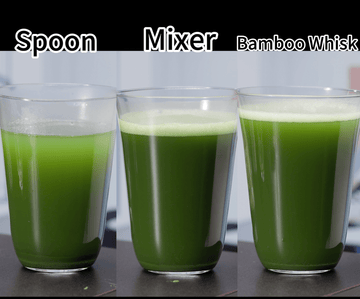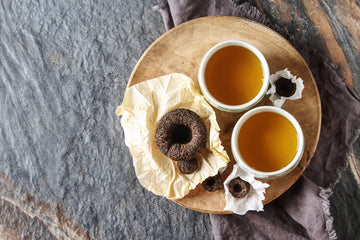Matcha is an incredibly versatile and flavorful green tea that’s become increasingly popular. The key to an authentic matcha experience lies not only in the quality of the tea but also in how you prepare it. Today, we’re exploring three different methods to prepare matcha: spoon stirring, using an electric mixer, and the traditional bamboo whisk method. Let’s dive into the pros and cons of each and see how they impact the taste, texture, and overall matcha experience.

1. Spoon Stirring
The spoon stirring method is the simplest and quickest way to prepare matcha. All you need is a spoon, a cup of hot water, and some matcha powder. Simply add the powder to the water and stir it in.
What to Expect:
- Texture: The matcha doesn’t dissolve completely, leading to large clumps. While the taste isn’t terrible, it lacks the smooth, silky texture of properly prepared matcha.
- Taste: The flavor is noticeable but lacks the delicate sweetness and umami that high-quality matcha should have.
- After 5 Minutes: You’ll notice that the matcha settles at the bottom of the cup, leaving an uneven consistency.
Why Choose This Method?
If you're in a rush or don’t have special tools, spoon stirring gets the job done quickly, though you may miss out on the full matcha experience.
2. Electric Mixer
The electric mixer is a more modern approach to making matcha. By using an electric frother or mixer, the matcha powder and water blend quickly and efficiently, eliminating clumps and creating a frothy texture.
What to Expect:
- Texture: The electric mixer does a fantastic job of dissolving the matcha, resulting in a smooth and frothy consistency.
- Taste: The freshness and natural sweetness of the matcha shine through, with a pleasant, balanced flavor.
- After 5 Minutes: The matcha remains well-mixed, with no settling or separation.
Why Choose This Method?
If you’re looking for speed and simplicity, the electric mixer is a great option. While it doesn’t offer the ritual of traditional methods, it’s the most efficient and produces a consistent cup of matcha every time.

The image shows the sedimentation of matcha made with a spoon and an electric mixer after 5 minutes.
During the experiment, we maintained strict control over the conditions, using the same weight of matcha (2g), the same water temperature (75°C), and the same water volume (30ml for making the matcha liquid, diluted to 150ml). As you can see, the matcha made with the spoon shows significant layering, and the solution appears more cloudy. In contrast, the matcha made with the electric mixer has much less sedimentation, and the solution looks more uniform.
3. Bamboo Whisk
The bamboo whisk, or chasen, is the traditional way of preparing matcha. This method involves whisking the matcha and hot water together in a bowl, creating a smooth, frothy tea with a delicate foam.
What to Expect:
- Texture: The bamboo whisk method results in a perfectly smooth texture, with a slight foam that adds to the overall experience.
- Taste: This method really brings out the fresh, sweet, and slightly vegetal flavors of the matcha. It also preserves the umami and delicate sweetness you expect from high-quality matcha.
- After 5 Minutes: The matcha stays well-mixed, with minimal sediment or separation.
Why Choose This Method?
The bamboo whisk method is ideal if you value the ritualistic aspect of preparing matcha. It may take a little longer, but it’s the best way to appreciate the full flavour and texture of matcha.

The image shows the sedimentation of matcha made with an electric mixer and a bamboo whisk after 5 minutes.
Conclusion: Which Method is Best for You?
- Spoon Stirring: Quick and convenient but lacks smoothness and full flavor. Best if you're in a rush.
- Electric Mixer: Fast, efficient, and easy, with great results. Ideal for those who want convenience without sacrificing flavor.
- Bamboo Whisk: The most traditional and authentic method. It offers the best texture and flavor but takes more time and effort.
Each method has its own unique advantages, depending on what you’re looking for in your matcha experience. Whether you prefer a quick and easy cup or enjoy the ritual of the bamboo whisk, there’s no wrong way to enjoy matcha—only the best way for you!








